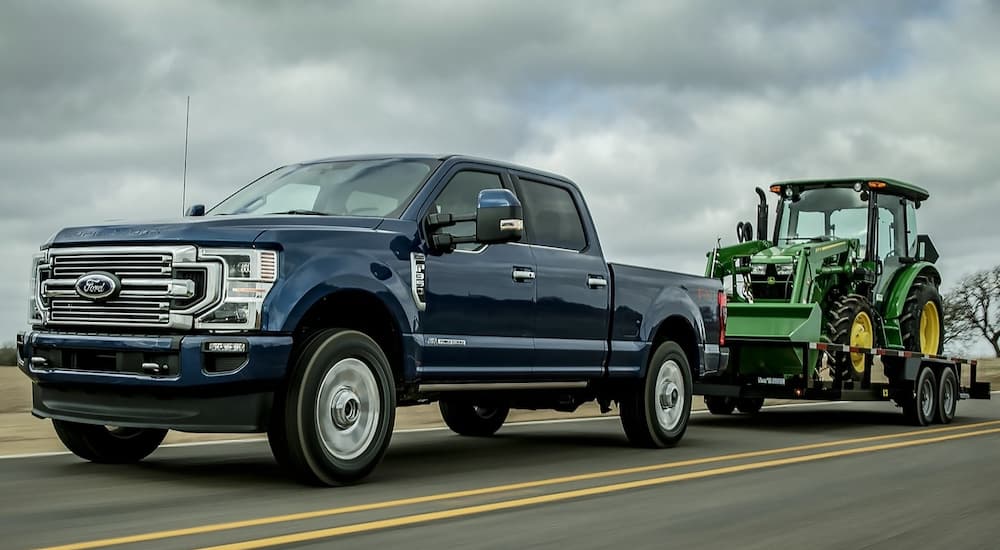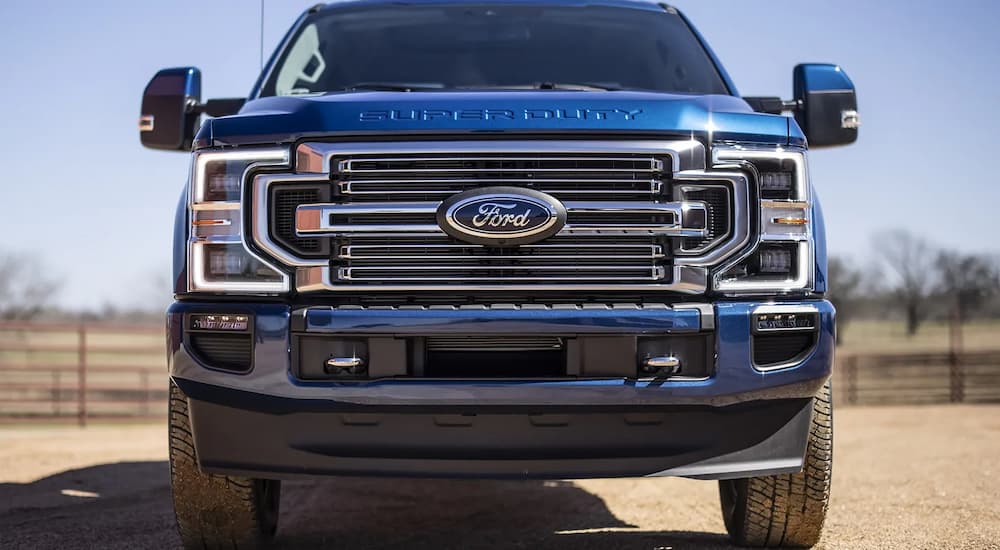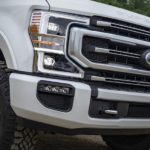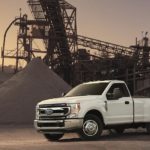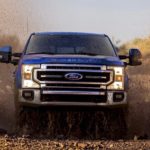Ford dealers are home to the pickups, chassis cabs, and medium-duty trucks that make up Ford’s iconic Super Duty line. Introduced in 1999, it’s come a long way since its assembly line first split from the F-150s. The Super Duty line began as an extension of Ford’s F-Series, one aimed at pairing the comfort of a passenger car with the capability of a commercial vehicle. Prior to 1999, Ford’s F-250-and-up trucks shared several components, including a body, with the F-150.
While this was an effective tool for cost-cutting, it muddied the line between heavy and light-duty pickups, so Ford created a new platform for the F-250 and above. Thus, the Super Duty pickup was born, bringing with it a unique body, increased interior space, heavier duty frames and suspensions, and brawnier engine options. Compared to the F-Series as a whole, the Super Duty line has been around for a relatively short amount of time. Still, a side-by-side comparison of a 1999 pickup and a model found at your 2022 Ford Super Duty dealer will render quite the juxtaposition.
Then and Now: Engines
The heart and soul of a working truck can be found under the hood. A powerful vehicle demands a powerful engine, and since 1999, vehicles have been trending in a more lightweight, fuel-efficient direction, presenting a conundrum for engineers designing trucks that can move thousands of pounds. Fortunately, with the aid of ever-improving technology, engines have picked up more power while going easier on fuel.
At its inception, Ford’s Super Duty line had three engine options available for its heavy haulers: a 5.4 liter Triton V8, a 6.8 liter V10, and a 7.3 liter Power Stroke diesel. The base-level V8 produced 235 hp and 335 lb-ft of torque. The upgraded V10 generated 275 hp and 410 lb-ft of torque, and the diesel option, the Power Stroke, made 235 hp and 500 lb-ft of torque, making it the most powerful diesel engine on the market at the time of the Super Duty line’s debut.
These days, the Super Duty trucks have three modernized engine options, which serve a larger variety of needs. There’s the 7.3-liter OHV PFI V8, a gasoline engine that puts out 430 hp and 475 lb-ft of torque. The diesel Power Stroke is still an option, although now it’s a turbocharged 6.7 liter good for 475 hp and 1015 lb-ft of torque. Lastly, the newest Super Dutys have the option for a 6.2-liter Flex Fuel V8, designed to maximize torque exactly when you need it for heavy-duty hauling at lower RPMs.
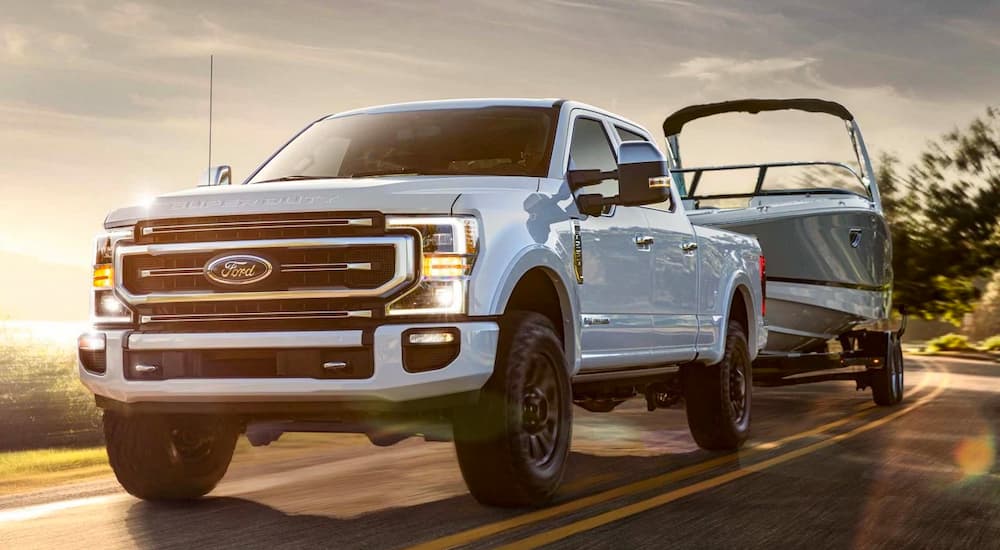
Towing and Hauling Just Gets Better and Better
In the arena of performance, Ford’s Super Duty line excels in all things hauling. Looking at engine outputs alone, it’s clear that Ford’s pickups have gotten more and more powerful as the years have rolled by, but how does that translate to actual capability? In 1999, towing capability varied widely depending on the specific configuration of the pickup. Are we looking at an F-250 with a regular cab? An F-550 chassis cab? The same holds true today, and the introduction of a slew of new trailering technology can also ramp up towing capacity. We’ll compare a few of the same models within the line to keep things simple.
For both 1999 F-250 and 1999 F-350, towing capacity peters out at around 10,000 lbs. The payload maximum for an F-250 and F-350 are 3,840 lbs and 5,975 lbs, respectively. For the medium-duty F-450 and F-550 chassis cabs, towing capacity can get in the ballpark of 18,000 lbs, and the maximum payload for an F-550 with dual rear wheels is 12,425 lbs. Bonus performance fact: the 1999 F-250 combined fuel economy rating is 14 MPG.
As for the 2022 Ford Super Duty, a modern F-250 can tow up to 22,800 lbs and has a payload capacity of 4,260. The F-350 can tow up to 35,750 lbs and has a payload capacity of 7,850 lbs with a chassis cab. Today, an F-550 can tow a whopping 37,000 lbs. An F-550 chassis cab has a payload capacity of 12,410 lbs. The fuel economy for a modern F-250 hasn’t changed much, it’s still getting about 14 to 15 MPG, but when you consider all the power gains, it’s actually kind of impressive.
Exterior Upgrades: ’99 vs ’22
Several new generations of the Super Duty have come and gone since the debut of the O.G. (original generation) in 1999, with each bringing their own set of tweaks to the size, appearance, and personality of the line as a whole. It’s like a game of telephone, with the end result being something new entirely, something that, if you squint, you can see some semblance of what it used to be.
In 1999, an F-250 with a regular cab had a wheelbase (distance between the front and rear axles) of 137.0 inches. Its overall length was 222.2 inches, and its overall width was 80.0 inches. Its steel body was beginning to take on the non-threatening, curved look of the 1990s, leaving the sharp corners of the 1980s behind.
Over the past couple of decades, the Super Duty has grown in several ways, literal size being one of them. Consumer preference has led to a great gigantifying of the car industry since more car means more space for stuff and people. While the width of a 2022 F-250 regular cab has stayed consistent at 80.0 inches, the wheelbase has crept up to 141.6 inches, and the length is now 231.8 inches. Its style has gotten more aggressive, too. The grille looks like it’s practically doubled in size and is framed by blocky headlights, all of which create a much more imposing front end. The body’s most revolutionary transformation, however, is one you can’t see with the naked eye. Instead of steel, it’s now made of a military-grade aluminum alloy. The material is highly durable and far lighter than steel. When it was first introduced, the new aluminum body was credited with a 350-lb weight deficit in the new Super Duty models.
Interior: An Evolution of Comfort
With the amount of time we spend driving, a vehicle’s interior can be something like a second home. It’s our cockpit, where we plant our rear ends and plug away, directing our vehicles to take us where we want to go. From this vantage point, user-friendly technology is on full display. This technology has gotten more and more sophisticated and digital, swapping buttons and dials for touch screens and voice commands. Our vehicles have gotten cozier, as well. Air conditioning has become a standard feature pretty much across the board, and power-controlled everything has taken the place of tiresome manual windows and seats.
As far as standard features for the 1999 Ford Super Duty line goes, the list is fairly short. A sound system consisting of an AM/FM radio and two speakers was included on the base-level trim. A/C was going to cost you extra. There were cup holders, at least, and something in the overhead console simply called a “general storage bin.”
Compared to the bare-boned Super Duty of 1999, even the base levels of the modern Super Duty feel luxurious. A/C is definitely included, as are rear view cameras (a game-changer for driving large pickups backward). Bump up to the top-tier Limited trim, and the standard features get downright exorbitant. Power-adjustable pedals, heated steering wheels, wireless charging pads, and innovative driver assistance features are merely the tip of the iceberg, which is actually just a huge diamond.
Super Work, Super Duty
Ford’s Super Duty line has been cranking out some of the best-selling work trucks since its debut, meaning the amount of productivity that can be attributed to these vehicles is unfathomable. The 1999 Ford Super Duty pickups were absolute workhorses, and each generation has been more steadfast than the last. The latest iteration of the Super Duty line is the best combination to date, with a tenacious powertrain, durable body, and refined technology working together to make our jobs easier.
